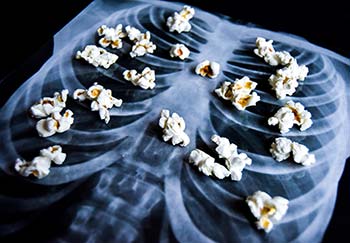
August 23, 2019 update: An alert issued by the Blue Ridge Poison Center and the U.S. Centers for Disease Control and Prevention (CDC) on August 21 reveals that vaping has started to have real consequences. The report notes that vaping has recently resulted in 100 cases of people going to the emergency room with serious lung illness and life-threatening symptoms. Clearly, as vaping becomes more popular, these kinds of concerns will only increase. The story of popcorn lung illustrates why.
Too Much of a Good Thing
Can we ever have too much of a good thing? For hundreds of years, authors like Cervantes, Shakespeare and Twain have all weighed the question. Philosophically, we may continue to wonder. But when it comes to popcorn lung, I’ve come to conclude that the answer is a definite YES.
The Popcorn Lung Story
It sounds like an urban myth. But this story actually happened. “This guy loved popcorn,” says pulmonologist Catherine Bonham, MD. “He made microwave popcorn every day, about two times a day, and when he opened the bag he would inhale the popcorn smell because he loved it so much.” The diagnosis for his lung issues couldn’t have been more fitting: This popcorn-lover had contracted popcorn lung.
This patient’s fate doesn’t mean you should never eat microwave popcorn again. Lung doctors Bonham and Tessy Paul, MD, sat down with me to explain the true lesson of the popcorn lung story. There is something to be said for moderation in all things — especially when we’re talking about our lungs and what we breathe into them on a daily basis.
Popcorn Lung Popping Up
But let’s back up. In 2000, in Jasper, Missouri, a local doctor had eight patients with breathing problems. Biopsies showed that all of these workers had bronchiolitis obliterans, a very specific and fairly rare lung disease.
The doctor noticed a pattern. Every single one of these patients worked at a local factory that produced microwave popcorn flavoring. And each of them were exposed on a daily basis to the flavoring mixture itself. All eight had worked there for many years.
These clues — and the fact that four of those initial eight patients required lung transplants — led to an investigation by the National Institute for Occupational Safety and Health (NIOSH). Bonham says they found that “half of the workers had some kind of lung problems, like asthma or bronchitis.”
But none of the workers had linked their conditions to their work environment. “Most of the time, when we think of occupational illness, we think of a one-time, really high-level exposure to something inhaled,” Bonham explains. “But in this case, the workers were inhaling this butter flavor over a longer period of time. So they weren’t associating their symptoms with being exposed at work.”
As Paul puts it, “They didn’t go home and have symptoms right away. It was just exposure over time.”
A Toxic Flavor
The investigators of NIOSH “sampled the environment and what the workers were breathing and found 100 volatile compounds.” Predominant among them: diacetyl, a buttery-tasting chemical.
The findings fingered diacetyl as the culprit at the root of the problem. When heated and inhaled over long periods of time, airway damage results. Inflammation in the lungs leads to a buildup of scar tissue that blocks and destroys airways. This damage, bronchiolitis obliterans, became known as popcorn lung.
Further investigations throughout the 2000s revealed that diacetyl occurs both in artificial and natural processes. Coffee roasting, for instance, produces the compound, whether or not the artificial flavor has been added. You can also find diacetyl in dairy products, candy, wine, beer and chocolate.
But the story doesn’t just tell us to remove diacetyl to make everything better. Paul explains that microwave popcorn manufacturers tried “substituting with another compound. But they found out the substitutions were just as bad.”
Bonham nods: “The take-home point is that exposing yourself to large amounts of chemicals, artificial or natural, doesn’t matter. Your lungs don’t know what to do with these aerosols when you’re breathing them every day, all day.”
The Effects of Popcorn Lung
The effects of popcorn lung are irreversible.
Bronchiolitis obliterans, a type of interstitial lung disease, literally “obliterates” or destroys the small airways in your lungs. Scar tissue builds up and blocks the air, making it harder for you to breathe. While some medications can slow this scar build-up, no treatment can remove the scars.
“It’s amazing to look at some of these biopsies under the microscope,” Paul notes. “With popcorn lung, we can see airways narrowed down or completely obliterated. It’s amazing how much damage you can cause.”
The Dangers of E-Cigs and Inhaling Over Time
Accumulation over time: This, not diacetyl, is the real cause of diseases like this. Not only does the damage occur to the lungs, but the slow progression undermines health providers’ ability to diagnose and warn people about the damage.
Bonham points to the rise of vaping as a prime example of this difficulty. “Lung doctors are so concerned about flavored e-cigarettes because they have these compounds, and we don’t know what they do. But we know from our experience with popcorn lung that some damage is being done. It might be damage that’s more low-level now, but as there’s an accumulation over time, it could be causing a serious health problem.”
Bonham notes that the story of popcorn lung should caution users of new products like e-cigarettes against trusting too much in safety claims made by companies. She points out that, like with the tobacco industry, manufacturers have no economic incentive to make the health risks of their products public.
With popcorn lung: “The companies had done their own testing on these chemicals, and they knew before 1993 that it killed the rats they exposed to it in the lab. But since it was private research, it wasn’t made public. They also had had leadership meetings talking about how to protect workers from flavoring compounds even before reports of popcorn lung came out. So, they knew it would come to be a problem or might be something they’d need to pay attention to, but there’s an economic incentive for companies not to make that kind of information public knowledge or let us know that this could be a problem.”*
Questioning the Marketing of E-Cigarettes & Vaping
“It’s really unfortunate, because a lot of these products are being marketed or tailored to really young people,” Paul says. “Teenagers, even middle school kids are using these products with bubble gum flavors or cinnamon flavors. These are not geared towards adults. Knowing that these kids at such a young age are being exposed is really disheartening. Who knows what we’ll be seeing ten years from now?”
The Symptoms of Popcorn Lung
Your primary care provider should note symptoms like:
- Short of breath
- Crackles (“sounds like Velcro or Rice Crispies”) detected with a stethoscope
- Cough that doesn’t go away
- Oxygen levels that nosedive when walking
Bonham agrees. “Some of these informational videos about flavoring and diacetyl and cigarettes characterize vaping as a fun hobby, with cartoon animations.” Her conclusion? E-cigarette marketing isn’t “targeted towards adults trying to quit tobacco. It’s trying to get a new generation smoking.”
The Claims of Ingredient Safety
Bonham notes that some online sources suggest that “without diacetyl in e-cigarettes, they’re harmless.” This claim doesn’t reveal the other nature of the other ingredients in vapors and flavoring, however.
For instance, Bonham points out that the chemical that creates the vapor in e-cigarettes and produces the white puff of smoke is polyethylene glycol— colonoscopy preparation solution.
“Think about coating your lungs with colon prep,” she says. “I think intuitively that’s a terrible idea.”
Bonham notes that some manufacturers have employed the ingredient-switching strategy in response to critique of polyethylene glycol, using propylene glycol as a substitute. “Some pro-vaping bloggers discuss that propylene is somehow safe to inhale. Another use of propylene glycol? Airplane de-icer.” And Bonham adds, like any other chemical additive, “Repeated exposures over time are likely to cause lasting lung disease in susceptible people.”
Problems Breathing?
Bronchiolitis obliterans is a type of lung condition called pulmonary fibrosis. Get tested for this lung disease right away.
The Supposed Safe Levels
When it comes to inhaling compounds, Bonham says, we’ve learned that “what’s a safe level for one person might not be a safe level for another person. Some people are more susceptible than others are.”
Exposing yourself to anything over time, she says, because studies haven’t found anything harmful in the substance, is “naïve. You’re being experimental — on yourself.”


Microwave popcorn is totally unhealthy anyway due chemicals in the bags and who knows what else they put in it. I am a popcorn lover, have even grown my own at times. At least purchase a stainless steel stovetop corn popper and pop your own with healthy oil.
It’s propylene not polyethylene
Ted, actually, both propylene glycol (PG) and polyethylene glycol (PEG) get used as vaping additives. They also both show up in antifreeze! Only PEG works as a colonoscopy prep, though. Thanks for helping clarify what is easily confused!
Looking forward to see more such posts in future 🙂
These flavors are not geared towards teens. They taste good, that’s why people enjoy them. My 65 year old mom chews bubblegum nearly daily, and people of all ages enjoy cinnamon rolls, candy, and fruit flavors. Just because people are adults doesn’t mean the only flavors we are allowed to like are strong black coffee, tobacco, menthol, and werthers originals. I quit smoking with vaping, and now cigarettes taste so disgusting compared to my vape. All of my juices are fruit or pastry flavors. It’s supposed to taste good, so that if you do have a cigarette, you’re disgusted with it.
I’ve been vaping for a few weeks and I’ve been having shortness of breath when I’m eating and even when I’m not moving and just sitting and I’ve also been having a bad chest pain that goes to my shoulders And I’m really worried if it’s a popcorn lungs or not and if yes, is there any medication that can fix this problem